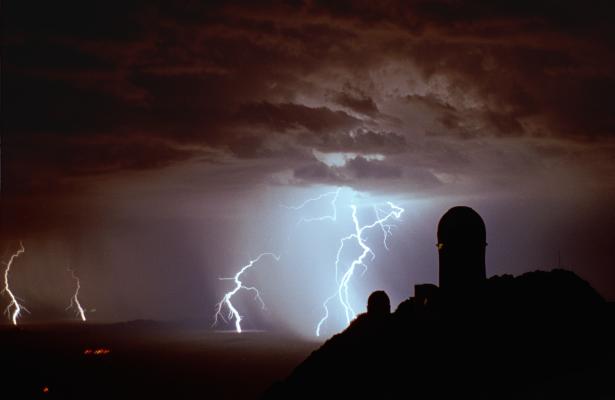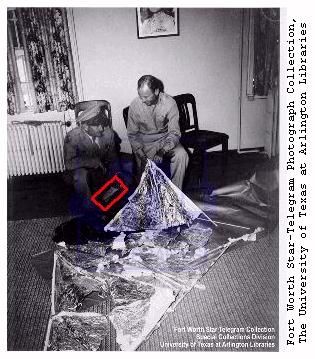Imagine driving down a dark country road and having the above, man-sized creature fly at your windshield, stare in at you and then swoop upwards into the night sky. This actually happened to a 53-year old LaCrosse man who prefers to be known only by his Cherokee name, Wohali, and the man's 25-year old son. Their reaction? Immediate illness. In seconds, both became physically ill, and the son, who was driving, swerved and then pulled the truck over into the ditch so he could vomit. The son, who wishes his identity kept private, vomited six or seven times. Wohali retched, as well, and both remained sick for an entire week. The son was so frightened by the encounter that he refuses to discuss it. But Wohali told me he feels it's important for people to "know what is out there," and wants the story to be told.The Man Bat. This sighting happened Tuesday, Sept. 26, on Briggs Road near LaCrosse between 9:15 and 9:30 pm. The creature almost flew into their windshield, was an estimated 6-7 feet tall, sported batlike, leathery wings with a span of 10-12 feet, long claws on its feet and "hands" and a snarling expression on the face. They both somehow felt it was angry it had been seen. "When we turned onto Briggs Road," wrote Wohali in his hand-written account, "our little 4-wheel drive truck's headlights caught (in mid-air) a bat-like, man-like creature (we almost smacked it with our windshield) that was six or seven feet tall with abouta ten or twelve foot wingspan." The large muzzle featured rows of sharp teeth, and the creature "screamed" at them before sailing straight up into the air. The encounter made both men physically ill, sick to their stomachs and vomiting the rest of the night. Wohali stated that he did not know whether the creature had been on the road and then bounced up at them, or if it had been flying at the time it came at their car. He was sure the thing was a physical, actual creature, he said, but like nothing he had ever seen before. The drawing above includes more details than he actually saw during the few seconds of the encounter, he said, but "the face was hard to see clearly because the mouth and teeth were so prominent. It looked hungry.""Sorry about the cartoonish drawing," he wrote, "but it was so unreal that all I really remember is what you see." Wohali further described it as having "distended ribs, long sort of human legs with claws, huge bat-like wings with 'arms' sort of attached, I remember the teeth and the scream we heard was terrifying." Wohali added, "I've been living in this valley all my life and have seen some strange things, after all the Mississippi Upper Wildlife Refuge is the largest in the country and right out my back door. It hides lots of strange creatures. But I've NEVER seen anything like this. Rent the movie Bram Stoker, Dracula, the Dracula creature looks like it or better yet like the one in Van Helsing."
Briggs Road is a short stretch about a mile long just west of Holmen, which is north of LaCrosse. Briggs Rd. runs north and south between Cty. Hwys. XX and V, intersected by Hwy. 53 about midway. Immediately to the west is a large marsh, to the east is Halfway Creek. A mile north is the Van Loon State Wildlife area, and the road itself lies along the Amsterdam Prairie. The south end of the road sits about a mile and a half north of the Upper Mississippi River Natioanl Wildlife and Fish Refuge and Lake Onalaska. The road makes an immediate rise as you head north, and it was near the crest of the hill, less than a quarter mile from the road's south entrance, that the creature was seen. On the west side of the road, just before the sighting area, is a fenced off area that appeared to be some type of utility location, and on the east side was a shooting range and club. The west side of the sighting area features a row of bramble-type, dense vegetation.
INVESTIGATION:
I was able to visit the site in person with Wohali and a friend of his who is a veteran deer hunter and butcher. It was on October 14, eighteen days after the sighting (best I could do due to previous commitments). We drove there in the daytime first, and examined the area for footprints, but the surface was either asphalt roadbed or covered with tough, marshy grass or vegetation. However, we did notice something white on the west side of the road at the exact point the sighting occurred. We paced it to be twenty-five feet from the roadside. It was a strangely mutilated deer carcass, which appeared to have been deposited in a woodsy spot covered by brambles. There were no visible drag marks and a complete absence of blood on the ground. The deer carcass lay on its right side with its back facing the road, and the white area we saw was its exposed layer of winter fat, the skin having been peeled back from the midsection toward the forelimbs, which remained intact along with the head. No bullet wounds or bite marks were visible. There was no odor, probably because temperatures had ranged near freezing at night and only in the 50s daytime. The hunter with us estimated the carcass to be no older than three days, and its weight at about 60 pounds. The low weight estimate was due to the fact that the entire haunch section, lower abdomen and rear limbs WERE GONE!
saw was its exposed layer of winter fat, the skin having been peeled back from the midsection toward the forelimbs, which remained intact along with the head. No bullet wounds or bite marks were visible. There was no odor, probably because temperatures had ranged near freezing at night and only in the 50s daytime. The hunter with us estimated the carcass to be no older than three days, and its weight at about 60 pounds. The low weight estimate was due to the fact that the entire haunch section, lower abdomen and rear limbs WERE GONE!
The spine still protruded from the midsection, which by the way still retained the prized ribs and tenderloin that a hunter would certainly have taken, but the haunches appeared to have been ripped off. The remains did not appear to have been cut with a knife, said Wohali's Native American hunter friend. And the fact that the carcass was nearly bloodless and that there was no blood on the road or in the vicinity would indicate that the haunches were ripped off in another place where the carcass immediately bled out, and then it was carried to this spot and deposited. There were no APPARENTLY VISIBLE tooth or bite marks that would have been left by something carrying it in its mouth. We were not in a position to conduct a complete forensic examination of the animal. Oddly, an unused, unopened dark garbage bag lay adjacent to the carcass, toward the road. It's possible the deer was a "clean" road kill and someone had decided to butcher it and somehow lifted the fairly small deer and carried it back to the brambles for safekeeping, leaving the garbage bag with it. But why take the back legs and leave the good meat? And where did the blood go? Or the garbage bag could have blown against the deer from the road during recent storms. Wohali revisited the spot last week, which would have been about ten days after we discovered the carcass, and found absolutely no trace or remains of the carcass, not even a bone. I have to play devil's advocate and point out that the carcass could have been placed there no more than fifteen days (if the carcass was 3 days old) after Wohali's initial sighting of the creature. Therefore a connection to the creature is hard to prove. Also, because it was across the road from a gun club, one could easily imagine someone plugging an illegal deer and then going to some lengths to hide the evidence. But the fact that it was at the exact same point on the road as the sighting coupled with the curious physical condition of the remains still makes it worthy of note. We did return that evening about the same time of the initial sighting. Wohali, his friend, and I were passengers in a car driven by my friend and book reviewer Terri Schlichenmeyer. The carcass was still there and in the same condition we had found it earlier in the day. We parked in the ditch where Wohali and his son had pulled over, and watched in the darkness for about an hour. Wohali reported that he saw something shadowy in the treetops, and at one point, all three of them saw something large, black and slinky cross the road at the top of the hill. They said it looked like an inky ribbon unfurling. I saw nothing but perhaps was just not looking at the right place. Terri, I should add, was coming into the situation fairly uninformed, she happened to be my host for the weekend and was of a skeptical frame of mind about the situation. Finally, everyone felt quite unnerved and Wohali's friend, especially, urged us to leave the area immediately so we did.
connection to the creature is hard to prove. Also, because it was across the road from a gun club, one could easily imagine someone plugging an illegal deer and then going to some lengths to hide the evidence. But the fact that it was at the exact same point on the road as the sighting coupled with the curious physical condition of the remains still makes it worthy of note. We did return that evening about the same time of the initial sighting. Wohali, his friend, and I were passengers in a car driven by my friend and book reviewer Terri Schlichenmeyer. The carcass was still there and in the same condition we had found it earlier in the day. We parked in the ditch where Wohali and his son had pulled over, and watched in the darkness for about an hour. Wohali reported that he saw something shadowy in the treetops, and at one point, all three of them saw something large, black and slinky cross the road at the top of the hill. They said it looked like an inky ribbon unfurling. I saw nothing but perhaps was just not looking at the right place. Terri, I should add, was coming into the situation fairly uninformed, she happened to be my host for the weekend and was of a skeptical frame of mind about the situation. Finally, everyone felt quite unnerved and Wohali's friend, especially, urged us to leave the area immediately so we did.
Correlations:
I can't help but link this sighting to the mid-90s encounter another man and his son had by the riverbank in LaCrosse while hunting for a lost dog. They saw what they described as a "lizard man," covered in brownish scales and very reptilian-looking. It did not have its mouth open or arms extended Around the same time, a state DNR warden and separately, a group of highway workers saw what they described as a "reptile man" on Hwy. 13 near Medford. It also possessed wings and was able to fly out of their view (see Hunting the American Werewolf, p. 240-245) As I noted in "Hunting," the Medford spot was very near the Black River which winds up from LaCrosse! Could a creature be aerial and aquatic at the same time? Well, there are many water birds that manage the feat. Aquatic bats? Not so sure about that one.I can't imagine batlike wings being too great for swimming. And the feet Wohali saw were clawed, not webbed for paddling. Still, it seems odd that LaCrosse would be the locus of all these odd, man-sized creatures.Another item that bears mentioning is that LaCrosse is also the unfortunate site known for many drownings of college-aged males over the past couple of decades. The latest happened three days after Wohali's sighting. The last "rash," of which this drowning was the 7th, might be said to have started in 1997, the same approximate time as the sightings of the Reptile and Lizard man. Are these creatures some sort of death harbingers? Or totally unrelated? Your guess is as good as mine. On a more cryptozoological note, I have also found one other interesting "coincidence." On October 23, 2006, Biofort Blogger Scott Maruda reported that a William McManus claimed to have seen a huge bird near Stillwater, MN, that may have been a "Washington Eagle," a gigantic eagle species documented by John James Audubon in 1840. The Washington Eagle was dark, reddish brown and had a wingspan of ten feet, the same as the creature Wohali and his son saw, and a body length of three and one half feet. It would not, however, have displayed teeth or batlike wings with claws. Stillwater is only about 70 miles north of the Wohali sighting, along the same river. McManus saw the eagle-creature in winter of 2004. Does this mean that what Wohali really saw was the Washington Eagle (sometimes known as a sea eagle)? Well, the description just doesn't fit for the most part. But intriguingly, a similar pattern emerged with the sightings of another unknown flyer, Mothman of Point Pleasant, W. Virginia. Other very large birds...that were definitely birds....were observed by many witnesses at the same time the winged Mothman began terrorizing the area. Speaking of Mothman, could it have moved westward to the LaCrosse area, and is that what made Wohali and his son physically ill? Well, again the main similarity is size, along with the disturbing ability of both entitites to shoot straight up into the air. But what Wohali saw had a definite head, ears and fangs,with yellowish eyes, whereas Mothman was usually described as having no separate head, but with very large eyes that shined red when illuminated. And I didn't find any references to immediate nausea on the part of witnesses of Mothman in a quick glimpse at a few reference books on my shelf. So I don't think we can assume Mothman has migrated. And considering the other legacy of Mothman, the alleged curse that has caused so many deaths, I rather hope no other association with Mothey can be shown.
McManus claimed to have seen a huge bird near Stillwater, MN, that may have been a "Washington Eagle," a gigantic eagle species documented by John James Audubon in 1840. The Washington Eagle was dark, reddish brown and had a wingspan of ten feet, the same as the creature Wohali and his son saw, and a body length of three and one half feet. It would not, however, have displayed teeth or batlike wings with claws. Stillwater is only about 70 miles north of the Wohali sighting, along the same river. McManus saw the eagle-creature in winter of 2004. Does this mean that what Wohali really saw was the Washington Eagle (sometimes known as a sea eagle)? Well, the description just doesn't fit for the most part. But intriguingly, a similar pattern emerged with the sightings of another unknown flyer, Mothman of Point Pleasant, W. Virginia. Other very large birds...that were definitely birds....were observed by many witnesses at the same time the winged Mothman began terrorizing the area. Speaking of Mothman, could it have moved westward to the LaCrosse area, and is that what made Wohali and his son physically ill? Well, again the main similarity is size, along with the disturbing ability of both entitites to shoot straight up into the air. But what Wohali saw had a definite head, ears and fangs,with yellowish eyes, whereas Mothman was usually described as having no separate head, but with very large eyes that shined red when illuminated. And I didn't find any references to immediate nausea on the part of witnesses of Mothman in a quick glimpse at a few reference books on my shelf. So I don't think we can assume Mothman has migrated. And considering the other legacy of Mothman, the alleged curse that has caused so many deaths, I rather hope no other association with Mothey can be shown.
Briggs Road is a short stretch about a mile long just west of Holmen, which is north of LaCrosse. Briggs Rd. runs north and south between Cty. Hwys. XX and V, intersected by Hwy. 53 about midway. Immediately to the west is a large marsh, to the east is Halfway Creek. A mile north is the Van Loon State Wildlife area, and the road itself lies along the Amsterdam Prairie. The south end of the road sits about a mile and a half north of the Upper Mississippi River Natioanl Wildlife and Fish Refuge and Lake Onalaska. The road makes an immediate rise as you head north, and it was near the crest of the hill, less than a quarter mile from the road's south entrance, that the creature was seen. On the west side of the road, just before the sighting area, is a fenced off area that appeared to be some type of utility location, and on the east side was a shooting range and club. The west side of the sighting area features a row of bramble-type, dense vegetation.
INVESTIGATION:
I was able to visit the site in person with Wohali and a friend of his who is a veteran deer hunter and butcher. It was on October 14, eighteen days after the sighting (best I could do due to previous commitments). We drove there in the daytime first, and examined the area for footprints, but the surface was either asphalt roadbed or covered with tough, marshy grass or vegetation. However, we did notice something white on the west side of the road at the exact point the sighting occurred. We paced it to be twenty-five feet from the roadside. It was a strangely mutilated deer carcass, which appeared to have been deposited in a woodsy spot covered by brambles. There were no visible drag marks and a complete absence of blood on the ground. The deer carcass lay on its right side with its back facing the road, and the white area we
 saw was its exposed layer of winter fat, the skin having been peeled back from the midsection toward the forelimbs, which remained intact along with the head. No bullet wounds or bite marks were visible. There was no odor, probably because temperatures had ranged near freezing at night and only in the 50s daytime. The hunter with us estimated the carcass to be no older than three days, and its weight at about 60 pounds. The low weight estimate was due to the fact that the entire haunch section, lower abdomen and rear limbs WERE GONE!
saw was its exposed layer of winter fat, the skin having been peeled back from the midsection toward the forelimbs, which remained intact along with the head. No bullet wounds or bite marks were visible. There was no odor, probably because temperatures had ranged near freezing at night and only in the 50s daytime. The hunter with us estimated the carcass to be no older than three days, and its weight at about 60 pounds. The low weight estimate was due to the fact that the entire haunch section, lower abdomen and rear limbs WERE GONE! The spine still protruded from the midsection, which by the way still retained the prized ribs and tenderloin that a hunter would certainly have taken, but the haunches appeared to have been ripped off. The remains did not appear to have been cut with a knife, said Wohali's Native American hunter friend. And the fact that the carcass was nearly bloodless and that there was no blood on the road or in the vicinity would indicate that the haunches were ripped off in another place where the carcass immediately bled out, and then it was carried to this spot and deposited. There were no APPARENTLY VISIBLE tooth or bite marks that would have been left by something carrying it in its mouth. We were not in a position to conduct a complete forensic examination of the animal. Oddly, an unused, unopened dark garbage bag lay adjacent to the carcass, toward the road. It's possible the deer was a "clean" road kill and someone had decided to butcher it and somehow lifted the fairly small deer and carried it back to the brambles for safekeeping, leaving the garbage bag with it. But why take the back legs and leave the good meat? And where did the blood go? Or the garbage bag could have blown against the deer from the road during recent storms. Wohali revisited the spot last week, which would have been about ten days after we discovered the carcass, and found absolutely no trace or remains of the carcass, not even a bone. I have to play devil's advocate and point out that the carcass could have been placed there no more than fifteen days (if the carcass was 3 days old) after Wohali's initial sighting of the creature. Therefore a
 connection to the creature is hard to prove. Also, because it was across the road from a gun club, one could easily imagine someone plugging an illegal deer and then going to some lengths to hide the evidence. But the fact that it was at the exact same point on the road as the sighting coupled with the curious physical condition of the remains still makes it worthy of note. We did return that evening about the same time of the initial sighting. Wohali, his friend, and I were passengers in a car driven by my friend and book reviewer Terri Schlichenmeyer. The carcass was still there and in the same condition we had found it earlier in the day. We parked in the ditch where Wohali and his son had pulled over, and watched in the darkness for about an hour. Wohali reported that he saw something shadowy in the treetops, and at one point, all three of them saw something large, black and slinky cross the road at the top of the hill. They said it looked like an inky ribbon unfurling. I saw nothing but perhaps was just not looking at the right place. Terri, I should add, was coming into the situation fairly uninformed, she happened to be my host for the weekend and was of a skeptical frame of mind about the situation. Finally, everyone felt quite unnerved and Wohali's friend, especially, urged us to leave the area immediately so we did.
connection to the creature is hard to prove. Also, because it was across the road from a gun club, one could easily imagine someone plugging an illegal deer and then going to some lengths to hide the evidence. But the fact that it was at the exact same point on the road as the sighting coupled with the curious physical condition of the remains still makes it worthy of note. We did return that evening about the same time of the initial sighting. Wohali, his friend, and I were passengers in a car driven by my friend and book reviewer Terri Schlichenmeyer. The carcass was still there and in the same condition we had found it earlier in the day. We parked in the ditch where Wohali and his son had pulled over, and watched in the darkness for about an hour. Wohali reported that he saw something shadowy in the treetops, and at one point, all three of them saw something large, black and slinky cross the road at the top of the hill. They said it looked like an inky ribbon unfurling. I saw nothing but perhaps was just not looking at the right place. Terri, I should add, was coming into the situation fairly uninformed, she happened to be my host for the weekend and was of a skeptical frame of mind about the situation. Finally, everyone felt quite unnerved and Wohali's friend, especially, urged us to leave the area immediately so we did.Correlations:
I can't help but link this sighting to the mid-90s encounter another man and his son had by the riverbank in LaCrosse while hunting for a lost dog. They saw what they described as a "lizard man," covered in brownish scales and very reptilian-looking. It did not have its mouth open or arms extended Around the same time, a state DNR warden and separately, a group of highway workers saw what they described as a "reptile man" on Hwy. 13 near Medford. It also possessed wings and was able to fly out of their view (see Hunting the American Werewolf, p. 240-245) As I noted in "Hunting," the Medford spot was very near the Black River which winds up from LaCrosse! Could a creature be aerial and aquatic at the same time? Well, there are many water birds that manage the feat. Aquatic bats? Not so sure about that one.I can't imagine batlike wings being too great for swimming. And the feet Wohali saw were clawed, not webbed for paddling. Still, it seems odd that LaCrosse would be the locus of all these odd, man-sized creatures.Another item that bears mentioning is that LaCrosse is also the unfortunate site known for many drownings of college-aged males over the past couple of decades. The latest happened three days after Wohali's sighting. The last "rash," of which this drowning was the 7th, might be said to have started in 1997, the same approximate time as the sightings of the Reptile and Lizard man. Are these creatures some sort of death harbingers? Or totally unrelated? Your guess is as good as mine. On a more cryptozoological note, I have also found one other interesting "coincidence." On October 23, 2006, Biofort Blogger Scott Maruda reported that a William
 McManus claimed to have seen a huge bird near Stillwater, MN, that may have been a "Washington Eagle," a gigantic eagle species documented by John James Audubon in 1840. The Washington Eagle was dark, reddish brown and had a wingspan of ten feet, the same as the creature Wohali and his son saw, and a body length of three and one half feet. It would not, however, have displayed teeth or batlike wings with claws. Stillwater is only about 70 miles north of the Wohali sighting, along the same river. McManus saw the eagle-creature in winter of 2004. Does this mean that what Wohali really saw was the Washington Eagle (sometimes known as a sea eagle)? Well, the description just doesn't fit for the most part. But intriguingly, a similar pattern emerged with the sightings of another unknown flyer, Mothman of Point Pleasant, W. Virginia. Other very large birds...that were definitely birds....were observed by many witnesses at the same time the winged Mothman began terrorizing the area. Speaking of Mothman, could it have moved westward to the LaCrosse area, and is that what made Wohali and his son physically ill? Well, again the main similarity is size, along with the disturbing ability of both entitites to shoot straight up into the air. But what Wohali saw had a definite head, ears and fangs,with yellowish eyes, whereas Mothman was usually described as having no separate head, but with very large eyes that shined red when illuminated. And I didn't find any references to immediate nausea on the part of witnesses of Mothman in a quick glimpse at a few reference books on my shelf. So I don't think we can assume Mothman has migrated. And considering the other legacy of Mothman, the alleged curse that has caused so many deaths, I rather hope no other association with Mothey can be shown.
McManus claimed to have seen a huge bird near Stillwater, MN, that may have been a "Washington Eagle," a gigantic eagle species documented by John James Audubon in 1840. The Washington Eagle was dark, reddish brown and had a wingspan of ten feet, the same as the creature Wohali and his son saw, and a body length of three and one half feet. It would not, however, have displayed teeth or batlike wings with claws. Stillwater is only about 70 miles north of the Wohali sighting, along the same river. McManus saw the eagle-creature in winter of 2004. Does this mean that what Wohali really saw was the Washington Eagle (sometimes known as a sea eagle)? Well, the description just doesn't fit for the most part. But intriguingly, a similar pattern emerged with the sightings of another unknown flyer, Mothman of Point Pleasant, W. Virginia. Other very large birds...that were definitely birds....were observed by many witnesses at the same time the winged Mothman began terrorizing the area. Speaking of Mothman, could it have moved westward to the LaCrosse area, and is that what made Wohali and his son physically ill? Well, again the main similarity is size, along with the disturbing ability of both entitites to shoot straight up into the air. But what Wohali saw had a definite head, ears and fangs,with yellowish eyes, whereas Mothman was usually described as having no separate head, but with very large eyes that shined red when illuminated. And I didn't find any references to immediate nausea on the part of witnesses of Mothman in a quick glimpse at a few reference books on my shelf. So I don't think we can assume Mothman has migrated. And considering the other legacy of Mothman, the alleged curse that has caused so many deaths, I rather hope no other association with Mothey can be shown.


























